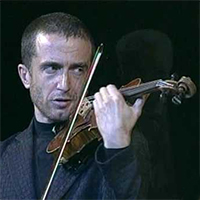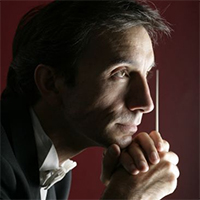
An almost-all-Shostakovich program began the Santa Rosa Symphony’s subscription season on Saturday in Weill Hall, Rohnert Park, with fine, deservedly cheered performances — and somewhat problematic interpretations by Music Director Bruno Ferrandis.
I had issues with Ferrandis’ choice of tempos in the final work on the program, the Russian composer’s Fifth Symphony. Now imagine this was the U.S.S.R. in 1948, and I were the petty tyrant Second Secretary Andrei Zhdanov. Wouldn’t this be a great time for some brutish grandstanding to impress Great Gardener Stalin?
If only we lived in those good old days, I could haul Ferrandis before a committee of my stooges, along with frightened members of a National Conductors Association under my control, demand that they issue denunciations of each other — the more severe, the better — and then order Ferrandis to give the keynote address (subordinate to my diatribe, of course) on how he could improve.

That’s just what Shostakovich and the Composers Union had to go through in January of that year, at the same time he was writing the third movement of his Violin Concerto in A Minor. (Steven Ledbetter’s program notes fail to mention this, instead implying that the concerto was already complete.) Whether it was intentional or not, he immortalized the stupidity of Zhdanov’s painful circus with a shoe-pounding passacaglia theme. As the stubborn theme goes through its iterations, the violinist (or is it Shostakovich’s soul?) soars above the shameful spectacle, eventually leaving it altogether in a five-minute-long cadenza of supreme mastery.
After a well-played appetizer of John Adams’ popular but irritatingly repetitive Short Ride in a Fast Machine, Ferrandis and Albanian soloist Tedi Papavrami got down to business with the Concerto. Papavrami’s smooth-as-silk tone was perfect for the innovative first movement. Denying the soloist the usual declamation for a first movement, Shostakovich instead requires him to use a mute during two long, ethereal sections punctuated with mysterious gongs. The audience was so impressed, there was a ripple of applause preceding the wild second movement, which Papavrami carried off with aplomb.
Papavrami’s smooth-as-silk tone was perfect… The audience was so impressed, there was a ripple of applause preceding the wild second movement, which Papavrami carried off with aplomb.
The passacaglia movement was taken at the right tempo, but, influenced by the history behind this music as I was, I felt the passacaglia theme itself wasn’t always threatening enough when it needed to be, and balances were also occasionally off. Papavrami’s cadenza, by contrast, was fabulous, and led everyone on to a satisfying finale. I hope to hear more from this violinist in the future; he has a distinctive personality.
Like the Violin Concerto, almost every major work of Shostakovich has extramusical baggage to go along with it. The famous Fifth Symphony is no exception. Much has been written about the tempo of the coda to the finale, which has 248 repetitions of a high A in the strings while timpani and brass are glorifying away. Should it be fast and rousing? Or, as attributed to Shostakovich in Solomon Volkov’s controversial book Testimony, should it be slower and heavily ironic?
It’s as though someone were beating you with a stick and saying, “Your business is rejoicing, your business is rejoicing,” and you rise, shaky, and go marching off, muttering, “Our business is rejoicing, our business is rejoicing.”

Ferrandis took the former approach — I think a valid one, in a purely musical sense, to avoid tedium and emphasize the apparent positive in the D-major chords. But for anyone attuned to the profound multiplicities of the composer’s utterances, such an approach comes across as naive.
In a less-discussed but just as important passage in the first movement, after a colossal climax at the end of the development section, Shostakovich hammers out three As over and over in the brass, a tempo con tutta forza. But with typical Shostakovian ambivalence, what does a tempo mean? There are two meanings in music: a return to the immediate tempo of the section; or the beginning tempo of the movement — fast in the former, much slower in the latter. Ferrandis took it fast, and he is not alone in this interpretation, but it is psychologically wrong: It is really another beating, with a club instead of a stick.The rest of the symphony was well-guided by Ferrandis. … Discounting a couple of minor blips, the orchestra performed terrifically.
Michael Tilson Thomas, in his brilliant Keeping Score program on this symphony, calls the three-note motive a “dead end,” essential to the profundity and structure of the piece. He, like many other conductors, takes these climactic thuds closer to the opening slow tempo. For me, unlike the first issue, this is the only musically valid way to do it, considering the movement as a whole.
Aside from the above key-tempo concerns, the rest of the symphony was well-guided by Ferrandis, especially at the magical conclusion to the third movement. Discounting a couple of minor blips, the orchestra performed terrifically, and was duly cheered by the crowd many times over.
Even Zhdanov, in his now exceedingly warm abode, would have loved it.

